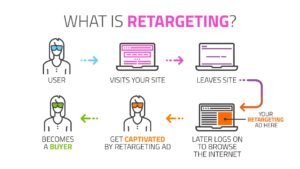Are you familiar with the new trends that can skyrocket your brand’s reach? Get to know 3 powerful tools that can upgrade your advertising game!
Technology has made it seamless to carry out core activities in many facets of the corporate world. With the advent of technology and its influence on media planning in the digital age, some trends are becoming the best way to reach a target audience.
Three of these trends include geotargeting, retargeting, and native advertising.
In the subsequent paragraphs, we shall discuss these trends and how technology is reshaping the landscape of media planning.
See Also: 5 Proven Media Buying Strategies for Business Success – Dominate Your Market
Media Planning in the Digital Age: Geotargeting, Retargeting, and Native Advertising
 Geotargeting:
Geotargeting:
Geotargeting is a sophisticated advertising strategy that delivers tailored content or ads to users based on their geographical location. This technique leverages the physical location data of users, often acquired through GPS signals or IP addresses. Combined with media planning, we can create highly localized and relevant campaigns that resonate with users in specific regions or locations by analyzing this location data.
Media planning in the digital age uses a sophisticated advertising strategy that involves delivering tailored content or ads to users. It works based on their geographical location. Geotargeting operates on different levels, including country, city, ZIP code, or even precise coordinates.
This approach allows media planning to optimize their messaging based on regional preferences, cultural nuances, and local events. Geotargeting enhances the user experience by delivering contextually relevant content and enhancing engagement.
See Also: Navigating the Pitfalls of Programmatic Media Buying: Best Practices for Success
 Retargeting
Retargeting
Retargeting, also known as remarketing, is a strategic advertising technique that re-engages users who have previously interacted with a brand’s website, app, or other digital assets. Bringing back users who might have shown interest but didn’t complete a desired action is the primary objective of retargeting. An example of such is making a purchase or filling out a form.
Also, it works by placing cookies or tracking pixels on users’ devices when they visit a website. These identifiers allow advertisers to display targeted ads to those users across various platforms and websites they subsequently visit. The retargeted ads often feature products or content the users previously engaged with. It reminds them of their initial interest and encourages them to take the desired action.
This technique capitalizes on the familiarity users have with the brand. Media planning in the digital age now uses this to leverage the principle of repeated exposure to influence decision-making. Retargeting campaigns can be fine-tuned to target specific segments of users based on their behavior and engagement history. This fine-tuning makes them a powerful tool for conversion optimization.
 Native Advertising:
Native Advertising:
In the media planning world, this refers to an advertising strategy that seamlessly integrates promotional content with the organic content of a platform. Doing this makes it appear as if it belongs there.
The goal of native advertising is to provide a non-disruptive and cohesive user experience by aligning with the look, feel, and context of the platform in which it is displayed. Native ads often match the format and style of the surrounding content, whether it’s a sponsored article that resembles editorial content, a video ad that resembles the platform’s video content, or a social media ad that blends with users’ feeds.
However, the key distinction is that native ads avoid overtly promotional language and design, aiming to engage users through valuable and relevant content.
Also, native ads aim to integrate seamlessly hence they are labeled as “sponsored,” “promoted,” or some other indicator of their commercial nature. This helps them to maintain transparency. This approach can result in higher engagement rates and a more positive user perception compared to traditional display ads, which are often seen as interruptions.
See Also: Essential Networking Tips For Communications Professionals
Technology and the Landscape of Media Planning in the Digital Age
To begin with, the infusion of technology into media planning has brought about a paradigm shift. It has empowered media professionals to make data-driven decisions, enhance audience targeting, optimize performance, and adapt to changing consumer behaviors.
In more ways than one, technology has begun to redefine media planning in the digital age. Gone are the days of relying solely on gut instinct and traditional demographic data. Media planning is now riding the data-driven wave, armed with insights that guide us toward the heart of our target audience.
Therefore, we can say technology has gifted us with a treasure trove of data – from social media interactions to browsing behavior. This information is like a compass, helping us navigate the vast sea of possibilities to reach the right people with the right message.
One of the game-changers in this landscape is programmatic advertising. It is like having an automated ally that bids for ad placements in real-time. We can now bid smarter, targeting specific demographics and even adjusting our bids based on the likelihood of conversions. It is an orchestra of algorithms that harmonize data and strategy seamlessly; a key consideration in media planning.
Although, it doesn’t stop there. Imagine a campaign that adapts to each viewer – that’s where Dynamic Creative Optimization (DCO) enters the stage. With DCO, we can now serve tailored content on the fly. If a viewer in Abuja is more interested in fashion, they will see a fashion-focused ad; if someone in Akwa-Ibom loves adventure, they will see a thrilling ad. Media planning in the digital age offers these and many more.
It is personalization at its peak, all thanks to technology.
Conclusion
However, speaking of personalization, we should mention the rise of AI and machine learning. These technologies are not about robots taking over; they’re about learning from consumer behavior to optimize campaigns. They sift through mountains of data to predict what works and what doesn’t. This means media planning is not just strategizing for today; we are strategizing for what’s likely to resonate tomorrow.
Therefore, media planning in the digital age is like painting a masterpiece on a canvas that spans various channels and devices. Technology has blessed us with cross-channel integration, ensuring our message remains consistent no matter where it’s seen.
Whether it’s a TV commercial, a social media post, or an in-app ad, the story remains unified, creating a seamless brand experience.
Finally, technology isn’t just another tool; it’s our ally in the pursuit of crafting campaigns that resonate deeply. With data as our guide and creativity as our fuel, we are navigating uncharted territories, revolutionizing media planning one pixel at a time.
So, let us embrace this digital wave and ride it to a future where our campaigns leave a lasting impact, all thanks to the transformative power of technology.
See Also: The Importance of Media Buying and Planning in Modern Advertising
Partner with us
It is time to unlock the full potential of your campaigns. Partner with QVT Media today and experience the beautiful intersection of technology and media planning firsthand. Let’s craft advertising symphonies that resonate with your audience and amplify your brand’s impact.


 Retargeting
Retargeting Native Advertising:
Native Advertising:
Really good👏👏